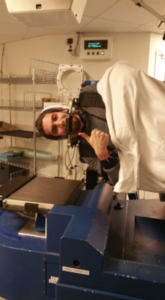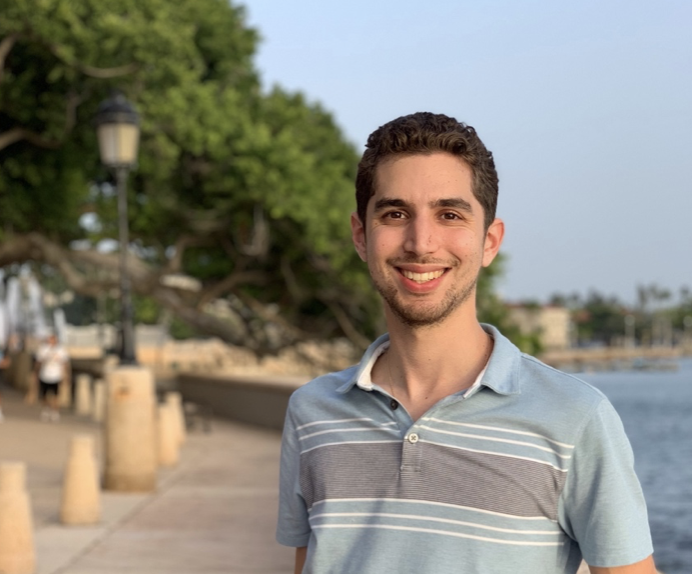Last March, I walked into the hospital not as a patient but as a medical student. It was my first clinical experience since I was diagnosed with a third occurrence of my brain tumor a year earlier. It was also not the family medicine clinic I had previously worked in as a medical student; instead, I would be shadowing a palliative care attending in a pediatric hospital.
Jeremy Pivor (center) pictured with his brain tumor walk team
Palliative care is a specialized form of care for people living with a life-threatening or life-limiting illness. It is often mistaken for hospice but may encompass any point of a patient’s journey with any goal — from curative to life-prolongation to comfort. Its aim is to reduce physical, emotional, mental, and existential suffering. It also helps patients and their families navigate life’s uncertainties in the face of serious illness.
Our lives are like a bridge. Usually its foundation is strong enough to support us throughout life’s ups and downs. However, when serious illness occurs, the physical and emotional weight of illness causes the bridge to crack. Palliative care provides scaffolding to hold our bridge together — a support to help those with serious illness keep living.
I was first diagnosed with a brain tumor when I was twelve years old. Ten years later, I had my first recurrence. I had surgery as a twelve-year-old, and radiation and chemotherapy when I was twenty-three. With these treatments, we hoped to kick the can of cancer down the road by 5, 10, or hopefully 20 years. However, only two years after I had finished radiation and chemotherapy — and nine months into my first year of medical school — I was diagnosed with another recurrence. This time, surgery and genetic testing, revealed that my tumor had evolved into a more aggressive form of cancer: A grade III anaplastic oligodendroglioma. In short, terminal brain cancer. The only treatments I had left were untested options. I tried a targeted molecular therapy meant for leukemia, but that didn’t prevent further growth. I then switched to a ten-day course of radiation followed by indefinite immunotherapy treatments every three weeks, which I continue to this day.
Last year, Jeremy shared his patient story with us. Click here to learn more about his thoughts on living well with terminal illness.

Jeremy during a radiation treatment, 2015
The existential crisis of my own mortality left me contemplating my values for how I wanted to live well and how I wished to have a peaceful end-of-life experience that fit my values. I had the opportunity to attend last year’s End Well symposium as a patient ambassador. The speakers, attendees, caregiver ambassadors, and fellow patients opened my eyes to the multitude of creative and innovative ways to transform how we can view and experience the end of life. One important area that stuck with me as someone not yet at the finality of my journey was palliative care. I realized palliative care could help me live my best life and reach the end on my own terms.
Words like palliative care, hospice, and the end of life are often associated with older adults. Rarely does an image of a child or a young adult come to mind. As someone who has lived with cancer as an adolescent and now as a young adult, I wanted to experience palliative care for younger people.
And so, six months ago, I walked through the doors of a children’s hospital to spend the day with the pediatric palliative care team. As I walked into the pediatric wing, I wasn’t sure what “hat” to wear: a medical student, a former child with cancer, or a young adult with cancer. The attending advised me to embrace whichever felt most appropriate in the moment.
As we walked down the hallway to our first patient, we stopped to let a boy through. He was around 12 years old, and used both a cane and an AFO (ankle/foot orthosis — a brace). I had flashbacks of my 12-year-old self in the hospital post-craniotomy relearning how to walk. I smiled, wanting to talk with him as a patient and show him the brace I continue to wear to this day. Wishing to assure him that, despite his physical challenges, there were so many possibilities ahead.
We continued onto our patient — a young girl with a birth defect that affected her breathing. She was connected to endless tubes for breathing, medication delivery, and blood testing. She wore her hair in two ponytails. And while she was unable to talk, she could react to sounds and physical touch. Nervous, I stood in the back while the attending talked with her mom. I wasn’t sure what to say, how to act, and what I could do to make this situation any easier for the girl or her mom.
In a moment of silence, I saw a beautifully colored bracelet on the girls left wrist and mentioned it to the mom. She smiled, replying that she had made it for her daughter — a form of connection between them. I stepped up to the girl, held her toe, and told her I loved her bracelet. She gave a slight smile and adjusted herself in the hospital bed. Her Mom smiled, translating her daughter’s movement as a form of affection towards me. I smiled back — my way of saying, “thank you” to the girl.
One of our last patients was a boy with a genetic condition affecting his lungs and other organs. He had been in and out of the hospital but was transferred to this specialty facility because he was likely to soon pass away. He couldn’t speak, but he was able to move around and open his eyes. His mom stood next to his crib while his older sister sat in a chair drawing in a coloring book.
Surrounding the boy were four stuffed animals from a storybook the mother had found to explain death to children. She told us that each animal represented a member of their family. As she read the story out loud to us and the boy, I held his left big toe covered in a tiny sock. He opened his eyes and looked in my direction as his mother read. It was one of the most heart-wrenching, beautiful moments I had ever experienced. We knew this boy would soon die, but his mom was courageously working to make his passing as loving as possible for both him and his entire family.
After the story, we all had tears in our eyes. I remarked to the mom how much strength she had. We discussed more ways for her to capture the story and life of her child as well as supportive services for his siblings. Throughout all of this, I held myself back from crying.
After leaving the boy’s hospital room, my attending and I debriefed. We talked through the boy’s case and everything that happened during our interaction with his mom. In our discussion, I realized my emotions stemmed from seeing my mom in the boy’s mother. My mother’s resilience and courage. What it might look like when I pass away.
On my way home from the hospital, unable to hold my tears in any longer, I cried. Witnessing the incredible fortitude of all the patients’ family members throughout the day brought my emotions to the surface. The bracelet, the stuffed animals, the variety of ways the families were coping with their children’s end-of-life experience filled my heart.
One year ago, before my surgery, I wrote my will. I felt content, and I’ve long been dealing with the reality of my own mortality. Even though the moments before my death will be sad and likely scary, I know how I want to live until the very end. What I didn’t fully account for was my family, both while I’m living and when the end of my life approaches.
My experience with these families in the hospital reminded me of my own family’s strength — especially my mom. My family supports me and endures my long-lasting and ultimately terminal illness. To go through that may likely be harder than my own patient experience because I am the one who receives the majority of the support from my family, friends, community, and health system. Not them.
The patients I saw were too young to help their families through this process, so it was often their moms who took charge. However, I am old enough to walk alongside my mom and family throughout my journey. To make sure we are all on the same page. To make sure that not only I receive palliative care, but they do as well. For me to end well, I need to know they will have the support they need, and to include them as equal partners throughout my end-of-life experience until my last breath.
Jeremy Pivor is a graduate student in the UC Berkeley-UC San Francisco Joint Medical Program. He was diagnosed with a brain tumor at the age of twelve, had a recurrence when he was 23, and is now undergoing experimental treatments for another life-limiting recurrence at 28.
Jeremy is a passionate advocate for the brain tumor and young adult cancer communities through writing, speaking, fundraising, and lobbying. He works alongside the National Brain Tumor Society, Dana Farber, UCSF, and End Well, and he is a co-moderator for the #BTSM (Brain Tumor Social Media) Twitter chat. He is a regular contributor for CURE, and his writings have also appeared in The Washington Post, Pulse-Voices from the Heart of Medicine, the End Well Project, and Dana Farber’s Insight blog. He is currently transforming his graduate thesis into a book about his illness experience.
You can follow his journey at Jeremys-Journey.com or on Twitter @JeremyPivor.
